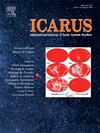露头尺度证据晚期流体流动和二次硫酸盐矿物在挖掘表面-地球与火星的比较
IF 3
2区 物理与天体物理
Q2 ASTRONOMY & ASTROPHYSICS
引用次数: 0
摘要
次生硫酸盐矿物在火星盖尔陨石坑中丰富,在某些情况下,在挖掘出来的沉积地层表面表现出独特的形态特征。这些是在侵蚀层理平面上亮色调的富含硫酸盐的晕状物和盐堆积,但它们的起源和含水过程仍不清楚。为了解决这一知识差距,我们研究了新墨西哥州里约热内卢Puerco流域富硫酸盐矿床的类似特征,以更好地了解它们的形成过程。在2012 - 2024年的5个月中,所研究的晕状特征、层理面和伪层中富集了石膏、芒硝、黄铁矿和六水石等多种Ca-Mg-Na硫酸盐矿物。这些富含硫酸盐的堆积在被挖掘出的沉积岩表面的露头尺度上很常见,但在某些年份,它们也可以在航空图像上看到。对单个湿月和干月的比较表明,它们的形成直接受与半干旱气候有关的幕式(短暂的)水活动的控制。大气水的间歇流动和入渗,以及地表和地表附近已经存在的富含硫酸盐的次生矿物的反复再溶解循环,导致它们在晕状特征、层理面和伪层中再沉淀和独特的堆积。我们假设,在火星盖尔陨石坑中观测到的富含硫酸盐的光晕和层理平面可能与过去干燥条件下的大气水活动引起的挖掘表面上或内部的后期流体流动有关。本文章由计算机程序翻译,如有差异,请以英文原文为准。
Outcrop scale evidesnce of late-fluid flows and secondary sulfate minerals on exhumed surfaces – Earth versus Mars comparison
Secondary sulfate minerals are abundant in Gale crater on Mars and in some cases exhibit distinctive morphological features on the exhumed surfaces of sedimentary formations. These are bright-toned sulfate-rich halos and salt accumulations on the eroded bedding planes, but their origin and aqueous processes are still not well understood. To address this knowledge gap, we investigated similar features of sulfate-rich deposits in the Rio Puerco watershed, New Mexico to better understand their formation processes. During five individual months between 2012 and 2024, the studied halo-like features, bedding planes, and pseudo-layers were enriched in various Ca-Mg-Na sulfate minerals such as gypsum, thenardite, bloedite and hexahydrite. These sulfate-rich accumulations were common at the outcrop scale on the exhumed surfaces of sedimentary rocks but in some years, they were also visible on aerial images. Comparisons between the individual wet and dry months suggest that their formation is directly controlled by episodic (ephemeral) water activity related to the semi-arid climate. Episodic flows and infiltration of meteoric water and repeated cycles of redissolution of the already existing sulfate-rich secondary minerals on and near the surface lead to their reprecipitation and distinctive accumulations in halo-like features, bedding planes, and pseudo-layers. We hypothesize that sulfate-rich halos and bedding planes observed in Gale crater on Mars might have been related to the late-stage fluid flows on or within the exhumed surfaces induced by past meteoric water activity under dry conditions.
求助全文
通过发布文献求助,成功后即可免费获取论文全文。
去求助
来源期刊

Icarus
地学天文-天文与天体物理
CiteScore
6.30
自引率
18.80%
发文量
356
审稿时长
2-4 weeks
期刊介绍:
Icarus is devoted to the publication of original contributions in the field of Solar System studies. Manuscripts reporting the results of new research - observational, experimental, or theoretical - concerning the astronomy, geology, meteorology, physics, chemistry, biology, and other scientific aspects of our Solar System or extrasolar systems are welcome. The journal generally does not publish papers devoted exclusively to the Sun, the Earth, celestial mechanics, meteoritics, or astrophysics. Icarus does not publish papers that provide "improved" versions of Bode''s law, or other numerical relations, without a sound physical basis. Icarus does not publish meeting announcements or general notices. Reviews, historical papers, and manuscripts describing spacecraft instrumentation may be considered, but only with prior approval of the editor. An entire issue of the journal is occasionally devoted to a single subject, usually arising from a conference on the same topic. The language of publication is English. American or British usage is accepted, but not a mixture of these.
 求助内容:
求助内容: 应助结果提醒方式:
应助结果提醒方式:


